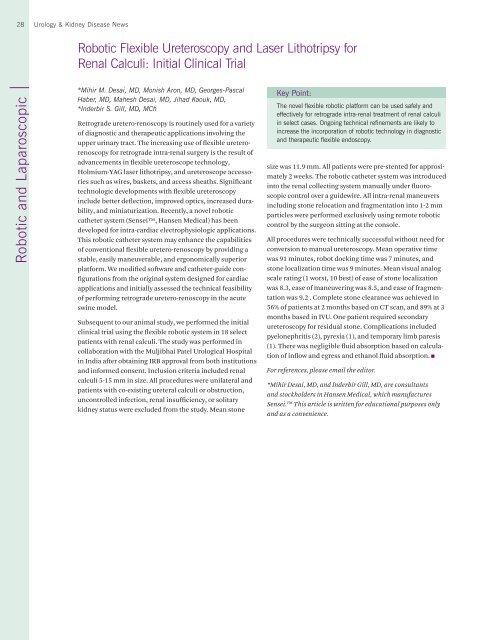Urology & Kidney Disease News - Cleveland Clinic
Urology & Kidney Disease News - Cleveland Clinic
Urology & Kidney Disease News - Cleveland Clinic
You also want an ePaper? Increase the reach of your titles
YUMPU automatically turns print PDFs into web optimized ePapers that Google loves.
28 <strong>Urology</strong> & <strong>Kidney</strong> <strong>Disease</strong> <strong>News</strong><br />
Robotic and Laparoscopic<br />
Robotic Flexible Ureteroscopy and Laser Lithotripsy for<br />
Renal Calculi: Initial <strong>Clinic</strong>al Trial<br />
*Mihir M. Desai, MD, Monish Aron, MD, Georges-Pascal<br />
Haber, MD, Mahesh Desai, MD, Jihad Kaouk, MD,<br />
*Inderbir S. Gill, MD, MCh<br />
Retrograde uretero-renoscopy is routinely used for a variety<br />
of diagnostic and therapeutic applications involving the<br />
upper urinary tract. The increasing use of flexible ureterorenoscopy<br />
for retrograde intra-renal surgery is the result of<br />
advancements in flexible ureteroscope technology,<br />
Holmium-YAG laser lithotripsy, and ureteroscope accessories<br />
such as wires, baskets, and access sheaths. Significant<br />
technologic developments with flexible ureteroscopy<br />
include better deflection, improved optics, increased durability,<br />
and miniaturization. Recently, a novel robotic<br />
catheter system (Sensei, Hansen Medical) has been<br />
developed for intra-cardiac electrophysiologic applications.<br />
This robotic catheter system may enhance the capabilities<br />
of conventional flexible uretero-renoscopy by providing a<br />
stable, easily maneuverable, and ergonomically superior<br />
platform. We modified software and catheter-guide configurations<br />
from the original system designed for cardiac<br />
applications and initially assessed the technical feasibility<br />
of performing retrograde uretero-renoscopy in the acute<br />
swine model.<br />
Subsequent to our animal study, we performed the initial<br />
clinical trial using the flexible robotic system in 18 select<br />
patients with renal calculi. The study was performed in<br />
collaboration with the Muljibhai Patel Urological Hospital<br />
in India after obtaining IRB approval from both institutions<br />
and informed consent. Inclusion criteria included renal<br />
calculi 5-15 mm in size. All procedures were unilateral and<br />
patients with co-existing ureteral calculi or obstruction,<br />
uncontrolled infection, renal insufficiency, or solitary<br />
kidney status were excluded from the study. Mean stone<br />
Key Point:<br />
The novel flexible robotic platform can be used safely and<br />
effectively for retrograde intra-renal treatment of renal calculi<br />
in select cases. Ongoing technical refinements are likely to<br />
increase the incorporation of robotic technology in diagnostic<br />
and therapeutic flexible endoscopy.<br />
size was 11.9 mm. All patients were pre-stented for approximately<br />
2 weeks. The robotic catheter system was introduced<br />
into the renal collecting system manually under fluoroscopic<br />
control over a guidewire. All intra-renal maneuvers<br />
including stone relocation and fragmentation into 1-2 mm<br />
particles were performed exclusively using remote robotic<br />
control by the surgeon sitting at the console.<br />
All procedures were technically successful without need for<br />
conversion to manual ureteroscopy. Mean operative time<br />
was 91 minutes, robot docking time was 7 minutes, and<br />
stone localization time was 9 minutes. Mean visual analog<br />
scale rating (1 worst, 10 best) of ease of stone localization<br />
was 8.3, ease of maneuvering was 8.5, and ease of fragmentation<br />
was 9.2 . Complete stone clearance was achieved in<br />
56% of patients at 2 months based on CT scan, and 89% at 3<br />
months based in IVU. One patient required secondary<br />
ureteroscopy for residual stone. Complications included<br />
pyelonephritis (2), pyrexia (1), and temporary limb paresis<br />
(1). There was negligible fluid absorption based on calculation<br />
of inflow and egress and ethanol fluid absorption.<br />
For references, please email the editor.<br />
*Mihir Desai, MD, and Inderbir Gill, MD, are consultants<br />
and stockholders in Hansen Medical, which manufactures<br />
Sensei. TM This article is written for educational purposes only<br />
and as a convenience.

















